
 |
|
|||||||
 |
|
|
Thread Tools | Display Modes |
|
#1
|
||||
|
||||
|
Beatles did not revolutionise music, study claims
British bands such as the Fab Four and the Rolling Stones only followed existing musical trends, researchers using data analysis say  So Yesterday? Researchers claim the Beatles followed established musical trends rather than setting them. Photograph: Michael Ochs archives They are credited with reviving rock’n’roll, setting the template for modern pop songwriting, and inviting a generation to turn on, tune in and drop out by embracing psychedelia. But a study questions quite how influential the Beatles were – claiming they were merely following musical trends already set in motion. Research by a group of London academics focuses on musical patterns in the US pop charts from 1960 to 2010, using data analysis to pinpoint the year in which trends appeared in the charts and measure their duration. The study’s findings may come as a shock to fans of the Rolling Stones and the Beatles, as its authors believe there is no musical evidence to suggest that the “British invasion” of the early 60s caused a revolution in the US charts at all. Rather, the music style those bands displayed – measured by properties such as chord changes and tone – was already established in the US charts before they arrived. The researchers believe they found evidence of a culture-shaking moment in pop, though – it just happened 30 years later. The emergence of hip-hop, which crash-landed in the charts in 1991, reinvented the musical landscape like nothing before or since, the study claims. Its lead author, Matthias Mauch, from the school of electronic engineering and computer science at Queen Mary University of London, believes the research breaks new ground in the way it measures musical trends. “For the first time we can measure musical properties in recordings on a large scale. We can actually go beyond what music experts tell us, or what we know ourselves about them, by looking directly into the songs, measuring their makeup, and understanding how they have changed,” he said. The researchers from Queen Mary and Imperial College London enlisted help from music website Last.fm to gather their data and employed methods such as signal processing and text-mining to analyse the musical properties of songs. Their work also uncovers several other interesting findings that appear to contradict the established wisdom when it comes to the story of pop. So 1983 – a year generally held to herald the arrival of UK synth pop bands in the US charts – is highlighted as a year that stood out for the arrival of country and disco. The idea that pop music has become less diverse is also disputed by the study, which names 1986 as the least diverse year in US chart history – which is attributed to the emergence of drum machines. The researchers state that there is no overriding trend that suggests the charts today are becoming more homogenous. Not everyone is convinced by the findings, however. Mike Brocken, a senior lecturer in music at Liverpool Hope University and director of the world’s first Beatles masters degree, said: “Popular music cannot be ‘measured’ in this way – what about reception, the political economy, subcultures? So my first instincts are to question any study that uses the dreaded data analysis.” He added: “I don’t think that the kind of formalistic musical analysis that is suggested here helps at all. The Beatles ‘communicated’ things to people; whether it was via an A-minor chord or an A-major chord really does not make the slightest difference. Semiotic approaches yield far more than chord shapes and time signatures.” Brocken accepts that in many ways the Beatles were not pioneers of the musical styles they played, but believes this fails to diminish the group’s standing in the pop canon. “Most decent popular music researchers would probably agree that the Beatles were not so much innovators as musical magpies – and that’s not a criticism. They, like all of us, listened to all sorts of stuff and were duly inspired,” he said. http://www.theguardian.com/music/201...c-study-claims |
| . |
|
#2
|
||||
|
||||
|
THE LARGEST VOCABULARY IN MUSIC
An analysis of vocabularies of top selling musicians Inspired by The largest vocabulary in hip hop, I wanted to do a similar analysis across a more generalised list of musicians. I stumbled across this List of best-selling music artists: https://en.wikipedia.org/wiki/List_o..._music_artists. The list is large enough (99 musicians and 25 genres) for the analysis to be interesting and small enough to not require complicated analysis techniques. The aim is to compare the vocabulary size of these musicians. Some of them have released a lot more songs than the others because of the sheer longevity of their career and how prolific they are. To prevent the analysis from being skewed purely by the number of songs released, the vocabularies are compared across the 100 densest songs (by total number of words) that they have released. Only 6 of these musicians have released less than 100 songs, so it is a good threshold. Also, 100 songs comprises 8 to 10 albums of music which would span at least 5 to 10 years of work. This should give a fair idea of the overall vocabulary of these musicians. Here are some definitions you should be acquainted with: • VOCABULARY SIZE The number of unique words (across any language) used by a musician in 100 (or less) densest songs across their career. • LYRICAL DENSITY The total number of words (across any language) used by a musician in 100 (or less) densest songs across their career. • NEW WORD INTERVAL (N.W.I) On average, the number of words after which a new word is used by the musician. This is the ratio of (Lyrical density / Vocabulary Size). An N.W.I of X means every Xth word in the lyrics of the artist is a new word, that is, a word he/she has never used before in any of his earlier songs. MR. OBVIOUS There are 4 rappers in the list and they are at the top of the vocabulary chart. Amongst them, Eminem leads Jay-z, 2Pac, Kanye West and The Black Eyed Peas by a big margin. Eminem also has the overall highest words per song ratio of 1018.5.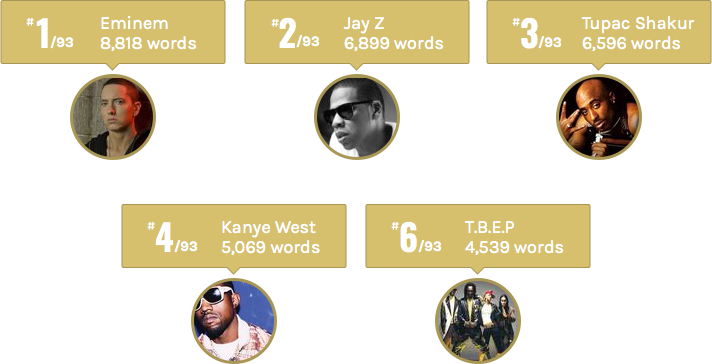 THE FREEWHEELIN' Given how articulate and descriptive his songs are, it is no wonder Bob Dylan ranks so highly. He also ranks at the top (#11) of the N.W.I ranking (on average he uses a new word after writing 9 words).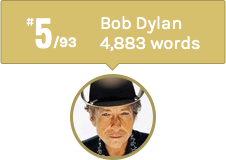 THE POLYGLOTS I had not expected a pop sensation like her to rank high since they rely on simplicity to get their message across. It lays bare my ignorance of her music. Also, she is the only one who ranks in the top 15 by vocabulary size as well as the total certified album sales.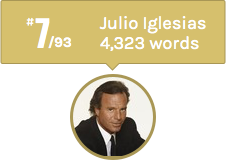 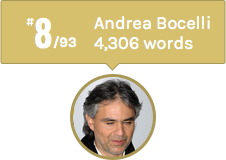 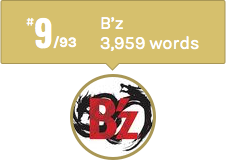 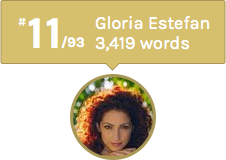 These superstars have released songs in multiple popular languages. Their vocabularies in different languages are getting summed up leading to a high overall vocabulary size. This was a result I was not expecting when I started the analysis. SURPRISE! 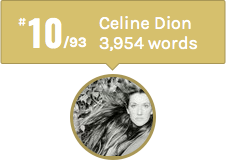 Not the least Whoever said songs can’t sell without lyrics.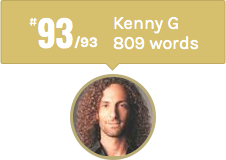 THE BIG PLATEAU The average vocabulary size across all the musicians is 2677 words. Around 40 musicians have a vocabulary size within 400 words of the average . Get your song-writing vocabulary size in this range to be a top selling artist.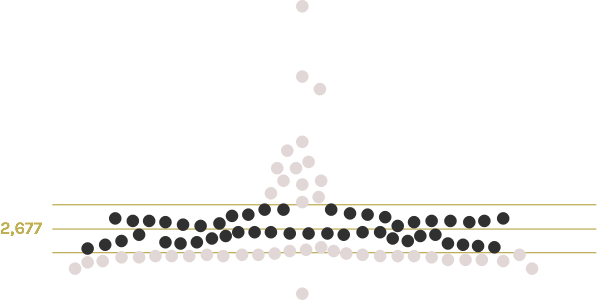 KEEP IT SIMPLE, SILLY! The three top selling musicians of all time rank low in the vocabulary chart. No wonder the simplicity of their lyrics breaks the barriers of geography, age, language and they are admired globally. Conversely, Mariah Carey ranks high in both the charts (#9 in the sales chart and #20 in the vocabulary chart).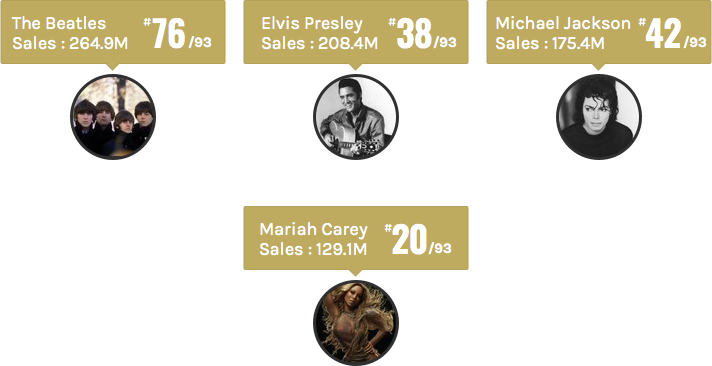 COMPARING GENRES The following chart shows the average vocabulary size of artists in different genres. In the parantheses is the number of artists in the list that sing in that genre. Since our list includes only 93 artists, it is not a very good generalization. >5000 WORDS: 1Hip Hop (5) >3500 WORDS: 2Folk (1) 3Latin (2) 4Funk Rock (1) >2000 WORDS: 5Progressive Rock (2) 6Alternative Rock (1) 7Heavy Metal (1) 8Funk (3) 9Punk Rock (1) 10Rock and Roll (1) 11Pop (24) 12R&B (6) 13Country (6) 14Rock (20) 15Glam Metal (1) 16Pop Rock (2) 17Hard Rock (8) 18Soul (1) >500 WORDS: 19Synth Rock (1) 20New Age (1) 21Reggae (1) 22Grunge (1) 23Teen Pop (1) 24Country Pop (1) 25Smooth Jazz (1) AVERAGE VOCABULARY SIZE FOR EACH GENRE Calculated for the top selling artists as per the Wikipedia article. ( ) denotes number of artists analyzed in that genre Some simple insights can still be taken. Hip-Hop is way ahead of the other genres (d’oh). Folk comes in second but since there is only one folk artist (Bob Dylan) in the analysis it is not representative at all. Pop is the genre with the most number of musicians and its average vocabulary size (2464 words) is close to the average vocabulary size across all artists (2677 words). Same thing applies to the Rock genre as well. TO SUM IT UP There is a large variation of vocabulary size in the 93 top selling musicians and there is no overall correlation between the commercial success of a musician and their vocabulary size. This analysis should not be interpreted as saying that one musician is better than the other, it is just another insight into the work of these amazing artists. It gives us a peek into the minds of different songwriters, some tear your heart with just a few words while others paint an intricate picture with a thousand words. Quoting John Lennon out of context explains this songwriter dilemma quite well - “Half of what i say is meaningless, but I say it just to reach you” - Julia, White Album ANALYSIS DETAILS All the lyrics data and other metadata (images, album lists, track lists, etc) is extracted using the Musixmatch API. Python is used for fetching the data and analyzing the lyrics. The analysis could be improved to remove coincidental sounds (ooh, aah, etc) and other such words which are not part of a dictionary. The data and the code will be released if anyone is interested. The largest vocabulary in hip hop compares the vocabulary of various musicians across the first 35000 words written by them. Instead of constraining by the number of words we used the 100 densest songs. Just out of curiosity (and for the sake of completeness) we used the same methodology by considering 10000 words written by each artist. The results of the two approaches don’t differ too much, the top 5 ranked musicians remain the same. The top 10 ranked musicians are the same with a slight shuffling of the ranks. Andrea Bocelli moves from #8 to #6, while Black Eyed Peas move from rank #6 to #7 and Julio Iglesias from #7 to #8. No significant changes are observed on the whole (more details). Thus, we used 100 songs as the constraint since it makes more sense intuitively and musically. - Varun Jewalikar and Nash Vail http://lab.musixmatch.com/largest_vocabulary/ |
|
#3
|
||||
|
||||
|
I saw a similar study done some time back regarding reading comprehension level and song lyrics. In essence, it broke down the musical genres lyrics and compared them to educational level equivalents. The results essentially matched this study: most pop songs lyrics used very simple vocabulary which could be easily digested by elementary school students. On the other side of the coin, many hip hop and rap artists implemented much more sophisticated terms and language that would require a considerably higher comprehension level.
__________________

|
|
#4
|
||||
|
||||
|
Oh, yes, my sister (that is graduated in english language and literature) told me about that article, but what I didn't understand is if that study took into account that people can (and usually do) listen to more than one genre.
However the weakness of this studies is that they can only consider the literal aspect of a word, not the semantic/figurative one. A language with lots of figure of speech is richer than one that is just descriptive, much more so if it comprehends less words in comparison. |
 |
|
|

Lindsey Buckingham/Christine McVie Self-TitledVinyl LP (2017 Warner) NM
$15.00
Christine McVie - Self Titled - Factory SEALED 1984 US 1st Press HYPE Sticker
$26.99
Christine McVie - In The Meantime [New Vinyl LP]
$31.24
Lot Of 3 Christine McVie ā€ˇRecords The Legendary Perfect Album
$30.00
$11.28